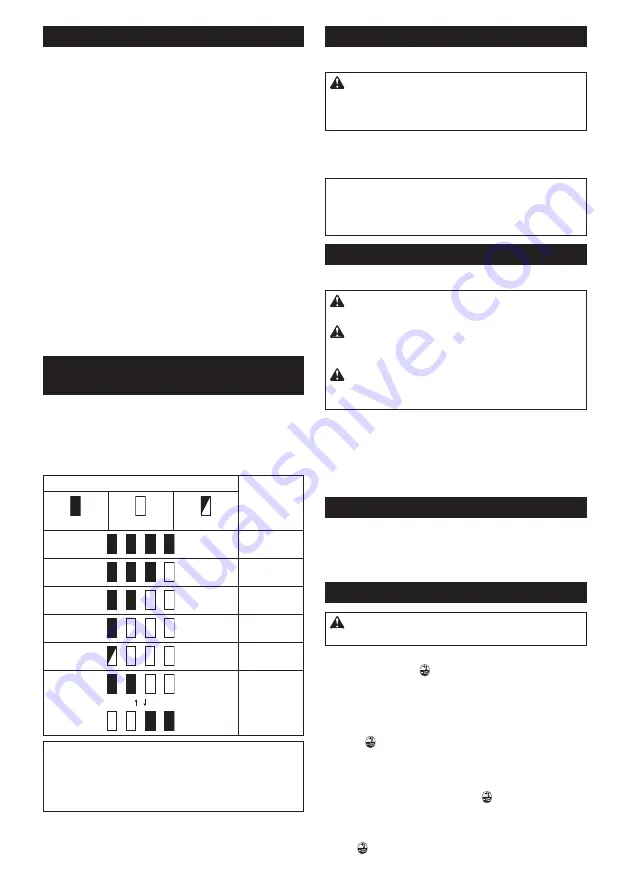
8 ENGLISH
Tool / battery protection system
The tool is equipped with a tool/battery protection sys
-
tem. This system automatically cuts off power to the
motor to extend tool and battery life. The tool will auto
-
matically stop during operation if the tool or battery is
placed under one of the following conditions:
Overload protection
When the battery is operated in a manner that causes it
to draw an abnormally high current, the tool stops auto
-
matically. In this situation, turn the tool off and stop the
application that caused the tool to become overloaded.
Then turn the tool on to restart.
Overheat protection
When the tool/battery is overheated, the tool stops
automatically and the lamp blinks. In this situation, let
the tool/battery cool before turning the tool on again.
Overdischarge protection
When the battery capacity is not enough, the tool stops
automatically. In this case, remove the battery from the
tool and charge the battery.
Indicating the remaining battery
capacity
Only for battery cartridges with the indicator
►
Fig.2:
1.
Indicator lamps
2.
Check button
Press the check button on the battery cartridge to indi
-
cate the remaining battery capacity. The indicator lamps
light up for a few seconds.
Indicator lamps
Remaining
capacity
Lighted
Off
Blinking
75% to 100%
50% to 75%
25% to 50%
0% to 25%
Charge the
battery.
The battery
may have
malfunctioned.
NOTE:
Depending on the conditions of use and the
ambient temperature, the indication may differ slightly
from the actual capacity.
NOTE:
The first (far left) indicator lamp will blink when
the battery protection system works.
Switch action
►
Fig.3:
1.
Switch trigger
CAUTION:
Before installing the battery car-
tridge into the tool, always check to see that the
switch trigger actuates properly and returns to
the "OFF" position when released.
To start the tool, simply pull the switch trigger. Tool
speed is increased by increasing pressure on the switch
trigger. Release the switch trigger to stop.
NOTE:
The tool automatically stops if you keep pull
-
ing the switch trigger for about 6 minutes.
NOTE:
While pulling the switch trigger, any other
buttons do not work.
Reversing switch action
►
Fig.4:
1.
Reversing switch lever
CAUTION:
Always check the direction of
rotation before operation.
CAUTION:
Use the reversing switch only after
the tool comes to a complete stop.
Changing the direc-
tion of rotation before the tool stops may damage the tool.
CAUTION:
When not operating the tool,
always set the reversing switch lever to the neu-
tral position.
This tool has a reversing switch to change the direction
of rotation. Depress the reversing switch lever from the
A side for clockwise rotation or from the B side for coun-
terclockwise rotation.
When the reversing switch lever is in the neutral posi-
tion, you cannot start the tool.
Electric brake
This tool is equipped with an electric brake. If the tool
consistently fails to quickly stop after the switch trigger
is released, have the tool serviced at a Makita service
center.
Lighting up the front lamp
CAUTION:
Do not look in the light or see the
source of light directly.
►
Fig.5:
1.
Front lamp
►
Fig.6:
1.
Button
2.
Switch panel
Pull the switch trigger to turn on the front lamps. To turn off,
release the switch trigger. The front lamps go out approxi-
mately 10 seconds after releasing the switch trigger.
To turn off the front lamps within 10 seconds, press and
hold the button for a few seconds.
To disable the front lamps, turn off the lamp status. To
turn off the lamp status, first pull and release the switch
trigger. Within 10 seconds after releasing the switch
trigger, press and hold the button for a few seconds.
When the lamp status is off, the front lamps will not turn
on even if the trigger is pulled.
To turn on the lamp status again, press and hold the
button for a few seconds.









































